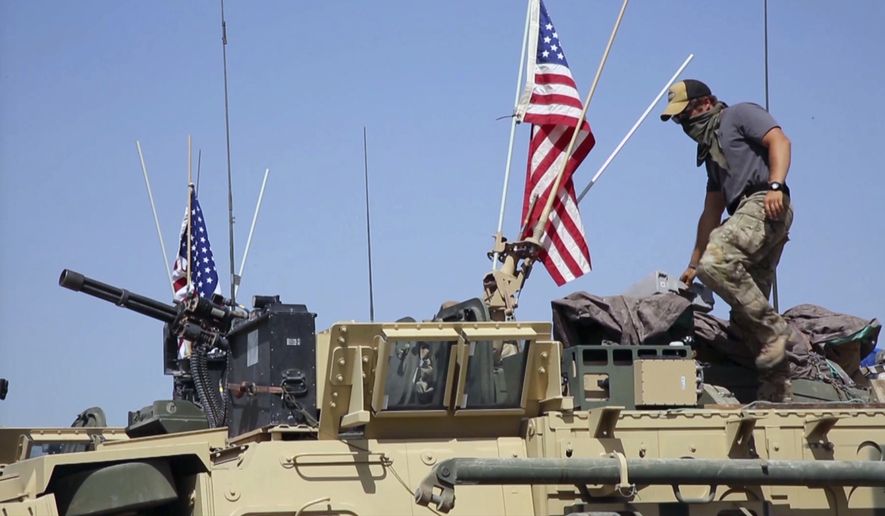The distinctive green and gold banner of the Syrian Kurdish militia known as the YPG flew alongside the Stars and Stripes this week, as U.S. troops and Kurdish paramilitaries took up positions in northern Syria’s enclave of Rojava.
The combination marked a dramatic show of solidarity by the Pentagon for the Kurdish force, amid Turkish airstrikes targeting those U.S.-backed forces there.
Images of Army Strykers and YPG vehicles rolling into Kurdish-held territory in Syria flooded social media on Sunday, as American commanders deployed the Army units into Rojava, near the Turkish-Syrian border, with the U.S. military staking out what could become a buffer zone to quell fighting between the militias and Turkish forces that threatens to derail the fight against Islamic State.
The move comes a week after Turkey, a NATO ally, launched a new round of airstrikes against YPG elements along the border region. Ankara characterized the strikes, which killed upwards of 70 Kurdish fighters, as a “counterterrorism” operation targeting members of the YPG, which Turkey charges has links to a Kurdish separatist movement inside Turkey that has long battled the government.
Members of the YPG are also part of the Syrian Democratic Forces, the constellation of Arab and Kurdish militias who are preparing for the large-scale assault on Raqqa, the self-styled capital of Islamic State.
On Monday, SDF forces recaptured the town surrounding the strategically vital Tabqa Dam, roughly 30 miles west of Raqqa. Securing the dam, along with the surrounding town and adjacent airfield, will provide Syrian and coalition forces with a prime launching point for future operations on Raqqa.
Turkish President Recep Tayyip Erdogan on Sunday vowed to carry out more strikes against Kurdish targets in northern Syria, telling reporters in Istanbul he was “saddened” by the images of the American and YPG flags flying in tandem.
Mr. Erdogan said he plans to raise the issue with President Trump during a White House meeting tentatively scheduled for mid-May.
Since the Obama administration rebuffed Turkey’s offer of support to retake the Syrian city of Manbij from ISIS control last year, Ankara has conducted unilateral operations in northern Syria. Turkish forces pushed as far south as the Syrian city of al Bab as part of Operation Euphrates Shield, which officially ended last month.
Since then, Turkey has been lobbying U.S. and coalition commanders for a role in the upcoming Raqqa operation, while simultaneously taking out YPG and other Kurdish militia targets via airstrikes. The most recent round of strikes prompted militia commanders to renew calls for a U.S.-enforced no-fly zone in northern Syria.
A no-fly zone “is the only solution for the lives of millions of Syrian people to be put under protection against future Turkish attacks,” YPG commanders said in a statement released Sunday, reported by Kurdish news outlet Rudaw. A safe zone patrolled by American and allied aircraft “will help keep millions alive and a stable north Syria is a stable regional situation,” they added.
The Trump White House has expressed support for Syrian no-fly zones, saying the measure could be vital to the thousands of Syrian civilians caught between the coalition offensive against ISIS and the Syrian civil war between anti-government forces and forces loyal to Syrian President Bashar Assad.
The no-fly zone established by the U.S. over northern Iraq’s Kurdish region required a resolution by the United Nations Security Council. Any move to create such a zone by the council would likely be blocked by Russia, which is backing Mr. Assad’s forces with air power and heavy artillery.
But regional experts, as well as current and former Turkish government officials warn that Mr. Assad would be the biggest beneficiary of any new no-fly or “safe zones,” arguing the Assad regime could use the zones as a haven and incubator for the YPG or other Kurdish elements deemed an enemy of Turkey — a haven protected by U.S. and coalition air power.




Please read our comment policy before commenting.